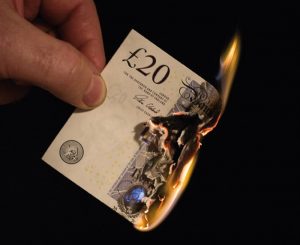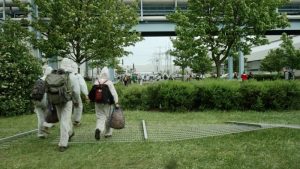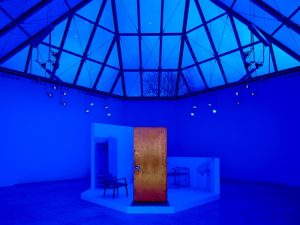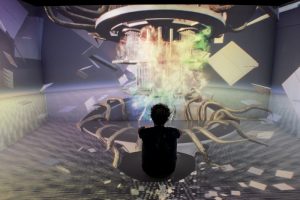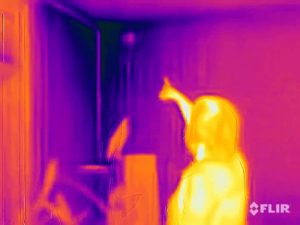A Leap into the Void. Art beyond Matter is an exhibition that opened a few weeks ago under the aegis of Yves Klein. At least, that’s what I imagine. The title is a nod to Klein’s 1960 famous Le saut dans le vide / Leap Into the Void. Klein experimented with people’s imagination, with transitory materials, air and immateriality in general. In the late 1950s, he worked with German architect Werner Ruhnau on plans for an air architecture that would rely on walls and ceilings of air. They even imagined a roof of moving air protecting a whole city. In 1958, his Le vide / The Void exhibition consisted of a white-painted room, completely except for a large cabinet and curtains. I’ll also mention one of my favourite works by the French artist: Zone de sensibilité picturale immatérielle (Zone of Immaterial Pictorial Sensibility), a performance and ritual which involved the sale of documentation of ownership of empty space in exchange for gold. The buyer had the option to burn the receipt, and Klein would throw half of the gold into the Seine.
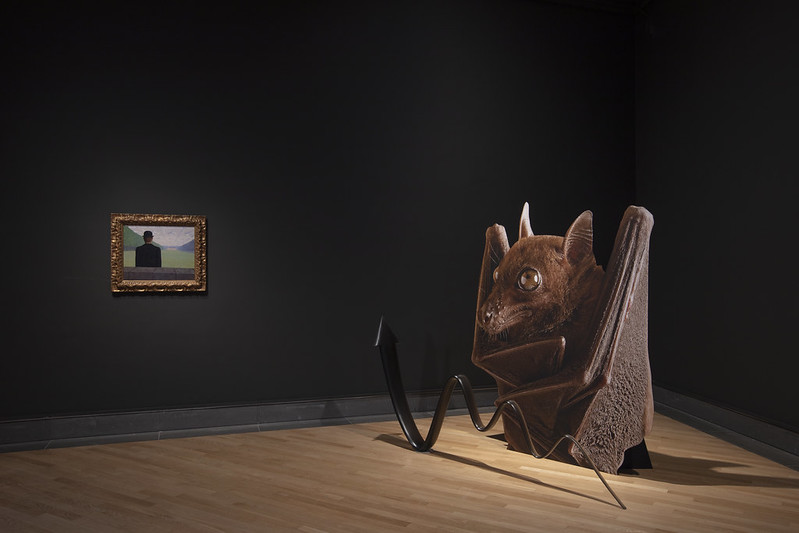
A Leap into the Void. Art beyond Matter/Salto nel vuoto at GAMeC. Photo: A. Maniscalco
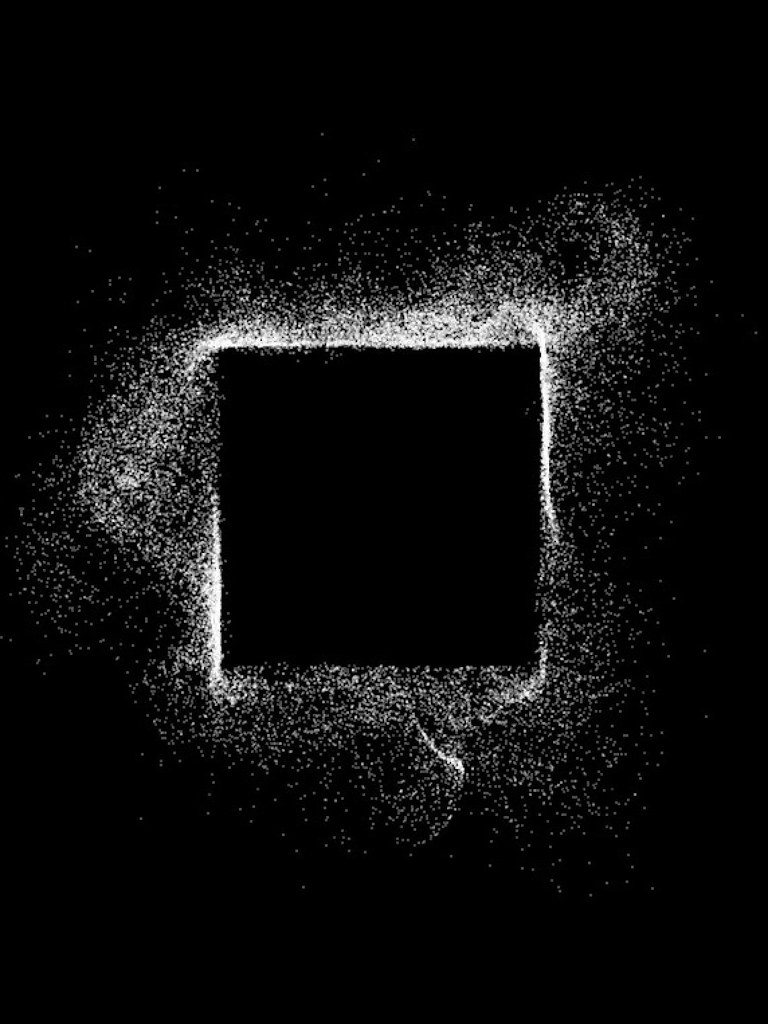
Antoine Schmitt, Black Square, 2016
A Leap into the Void, curated by Lorenzo Giusti and Domenico Quaranta at GAMEC in Bergamo, presents artists who, at different times throughout the 20th and early 21st century, have investigated dematerialisation or whose works have echoed epochal changes in the perception of the material dimension and in the material culture itself. There are no works by Klein in the show but there are fascinating artistic experimentations with matter, materiality and their exact opposites.
The exhibition is divided into three sections: Void, Flow and Simulation. The opening section is dedicated to the delicate representation of the void as an immaterial space. Flow brings together a selection of works from the avant-garde to the present day that testifies to the impact of computerisation and digital networks on the perception of material reality. Simulation, the final chapter in the show, delves into the merging of the physical and the virtual.
A Leap into the Void is a bright and witty show where Katja Novitskova dialogues with René Magritte, Duane Hanson with Lynn Hershman Leeson, Sol Lewitt with Casey Reas. The encounters play with art history, challenge the way most of us regard certain artworks and give unexpected depth to artworks I had, so far, either not paid much attention to or simply not understood.
A Leap into the Void concludes GAMEC’s Trilogy of Matter which explored the theme of dematerialisation. I missed the first show, Black Hole. Art and Materiality from Informal to Invisible, but I was very enthusiastic about the second episode: Nothing is Lost. Art and Matter in Transformation. Here’s a selection of works and ideas I (re)discovered in the current exhibition:
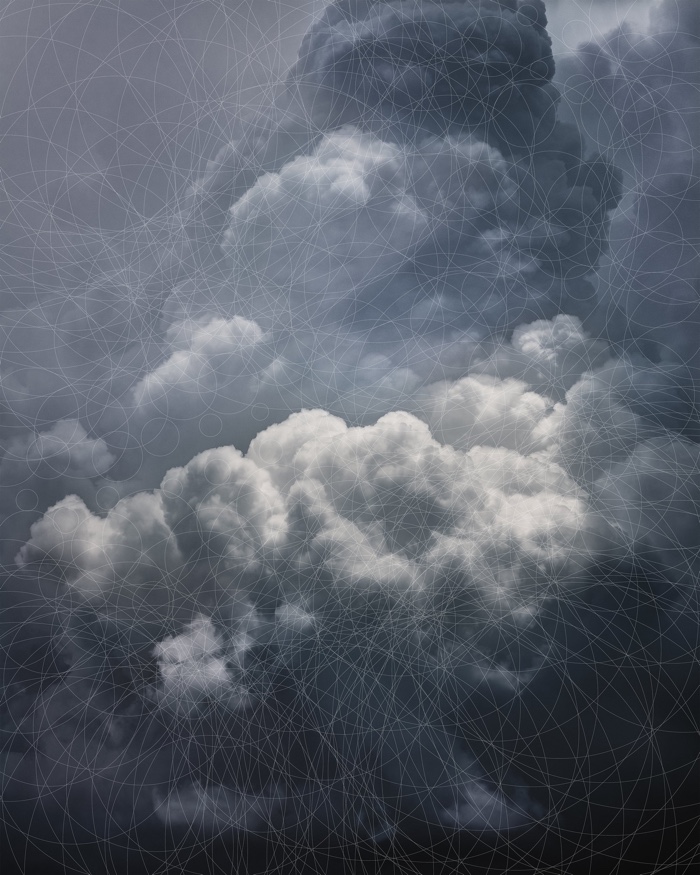
Trevor Paglen, CLOUD #865 Hough Circle Transform, 2019
Trevor Paglen’s magnificent photo of a cloud formation is overlaid with strokes and lines that illustrate what computer vision algorithms are “seeing” in the image. Different algorithms are designed to look for faces, unique key points, lines, circles and areas of interest, and are attempting to simplify the underlying photograph into a series of sections.
The algorithms used in Paglen’s works are fast becoming as ubiquitous as they are ambiguous. They are found in technologies that track license plates, pedestrian faces and movements, factory products but also guided missiles and drones and in many other computer vision contexts.
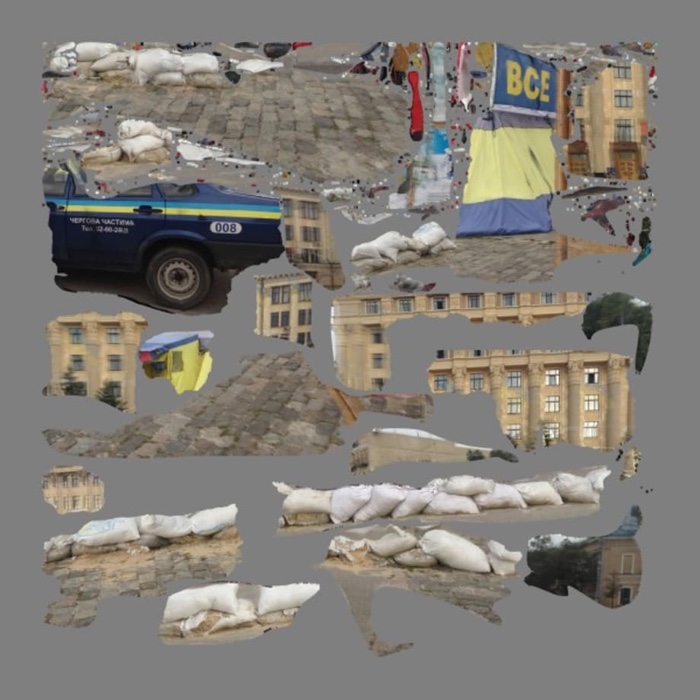
Hito Steyerl, Tent/Texture III, Kharkiv, 2015
Tent/Texture III, Kharkiv is a collage of 3D scans of objects and landscapes that Hito Steyerl made using a smartphone app while in Kharkiv in 2015, a time when the Ukrainian city was the site of a bombing as well as tensions between pro-Russian separatists and Ukrainian nationalists.
Instead of a seamless rendering of the scene, Steyerl produces a tableau of digitised parts: fractured images of sandbag piles, building sections, pavement, an Ukranian flag and a vehicle. By revealing how machines process what they “see”, these fragments enhance the disconnect between real and virtual realities but also between 2D and 3D. Both the aesthetics of the work and the objects represented foretell the barbarity gripping Ukraine today.
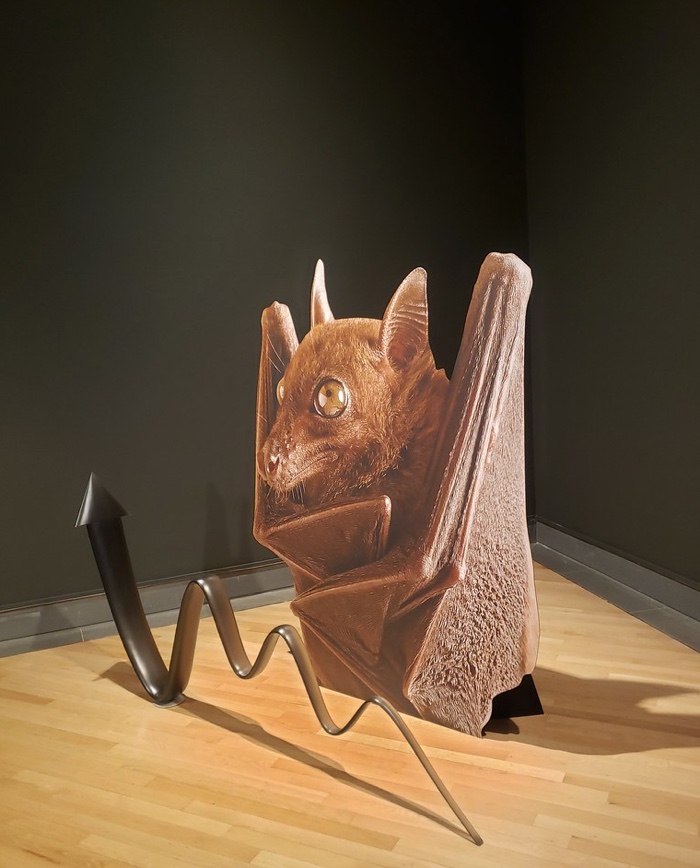
Katja Novitskova, Pattern of Activation (bat), 2014
Katja Novitskova finds images of animals or nature online, she then extracts them from their digital milieu, enlarges them and prints them on big aluminium banners. Images we tend to overlook online suddenly become massive sculptures that use the exhibition space as a glorified background. The Pattern of Activation series challenges us to reconsider the way we continually move from screen-based to 3D physical spaces. And back.
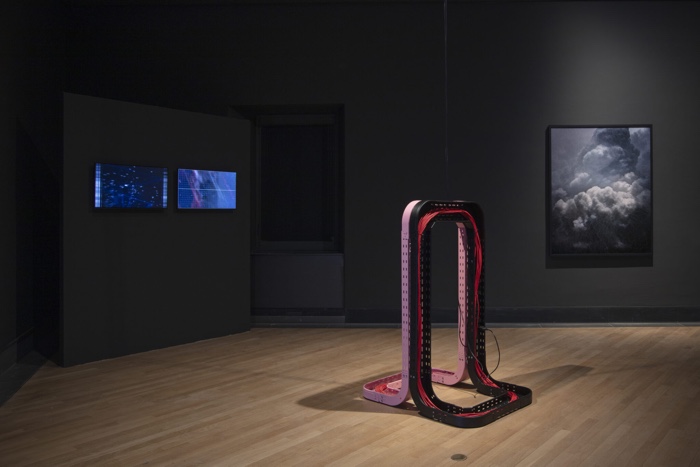
A Leap into the Void. Art beyond Matter/Salto nel vuoto at GAMeC. Photo: A. Maniscalco
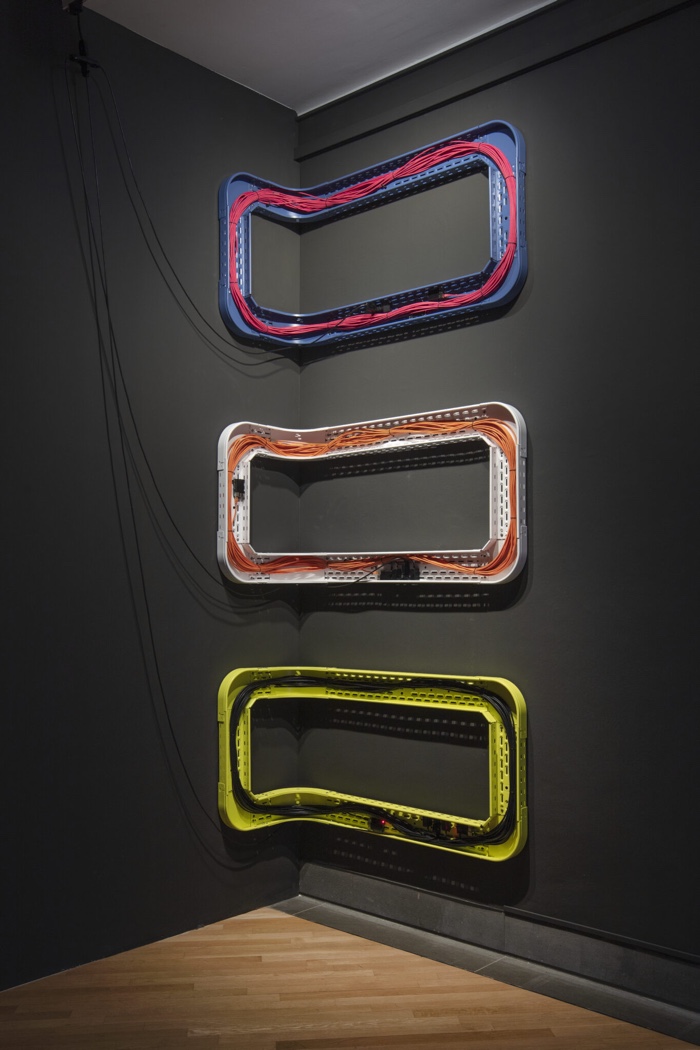
Eva & Franco Mattes, Personal Photographs, 2021-2022
The colourful cable trays of Eva & Franco Mattes’s installation host ethernet cables. Inside the cables, all the private photos that Eva & Franco Mattes took over the course of one month are rushing back and forth between two microcomputers. The work is visually striking. We could almost touch the data but we cannot see it. Like the billions of images made each day that no one will ever look at. Some of these unseen photographs are made by people, others by and for machines.
Personal Photographs plays with the contrast between the intangibility of data and the massive technical infrastructure that enables us to exchange them. The sturdy sculptures, with their bright colours and industrial aesthetics, also reminded me of the spectacularly seductive photos of the Google data centres.
Personal Photographs is almost the opposite of Life Sharing. For three years, starting in 2001, Eva & Franco Mattes made all the contents of their home computer accessible to the public. That experiment in radical transparency takes a new dimension today when social media have pushed the boundaries of what is acceptable to show and share. Keeping to photos to themselves as they do with Personal Photographs is, in this context, almost a subversive gesture.
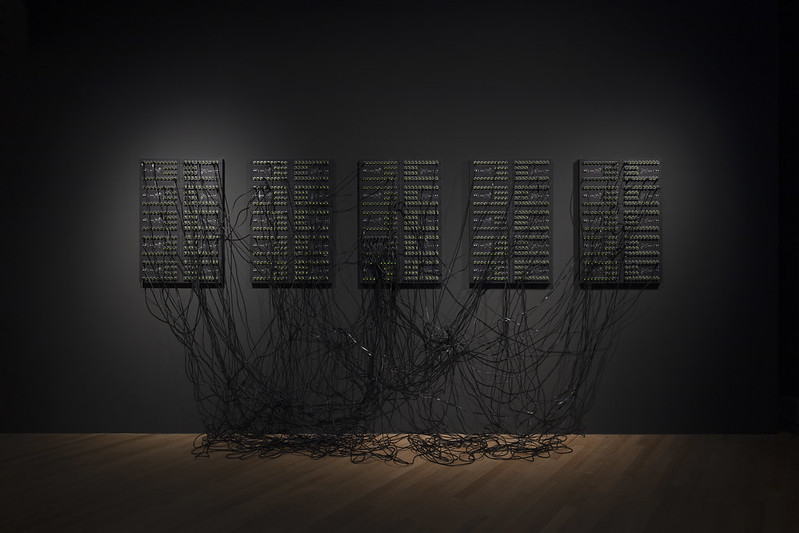
Addie Wagenknecht, XXXX.XXX, 2014. A Leap into the Void. Art beyond Matter/Salto nel vuoto at GAMeC. Photo: A. Maniscalco
Addie Wagenknecht‘s XXXX.XXX is a “packet sniffing sculpture.” The circuit boards tap into data streams on nearby Wi-Fi spots and analyse them. The sculpture does not share the outcome of the data processing with the public. Only the flashing of green lights indicates the ongoing process. The result is stunning, especially in low light, it is almost breathing and a bit intimidating.
By emulating a server room, the work focuses on the essential yet invisible machine architecture. With its black box aesthetics, the sculpture is also a portrait of our contemporary condition. We are increasingly dependent on technologies that are self-referenced, opaque and invasive. They accumulate information that we are unable to access or even understand. A mirror to our increasingly monitored and monetised life, XXXX.XXX reflects our wish for more privacy, transparency and safety to maintain our personal data.
The work is part of the series Data and Dragons that intercepts and logs anonymous live data captured from surrounding WiFi signals.
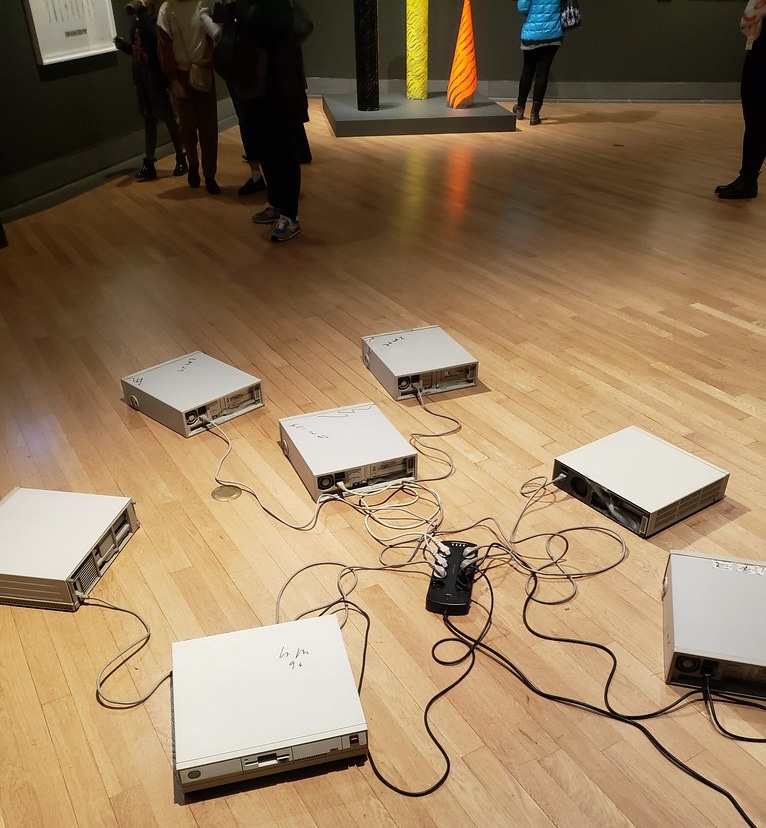
Maurizio Bolognini, Sealed Computers (Computer sigillati), 1992
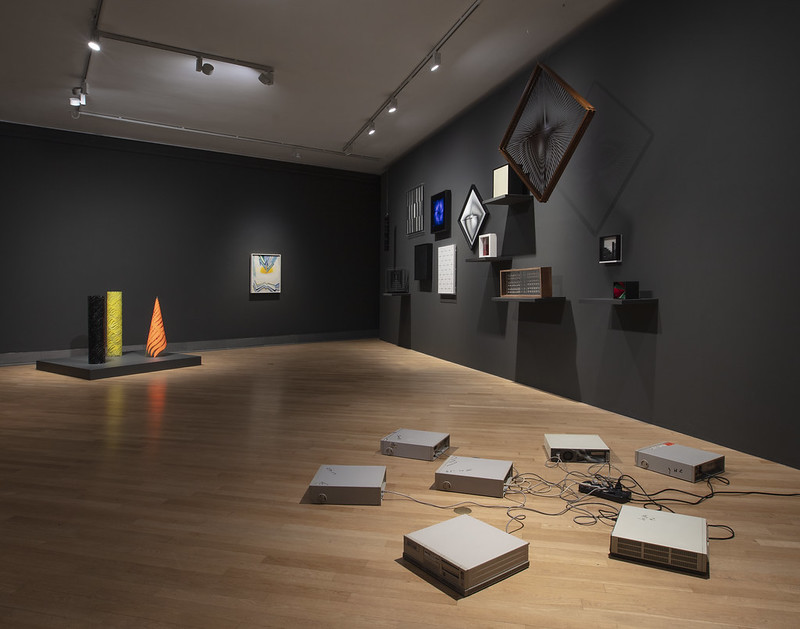
A Leap into the Void. Art beyond Matter/Salto nel vuoto at GAMeC. Photo: A. Maniscalco
Since 1992 Maurizio Bolognini has been programming machines to produce continuous flows of random images that no one will ever see. He then seals them with wax or silicone, so that they do not become connected to a monitor.
The computers on the gallery floor “collaborate” in network to calculate simple graphic structures. Human perception is useless: we never get to understand nor even sense the processes or their result. By frustrating viewers’ expectations, Bolognini’s installation puts the spotlight on an “aesthetics of the machinic” that shuns artistic intention and human interaction.
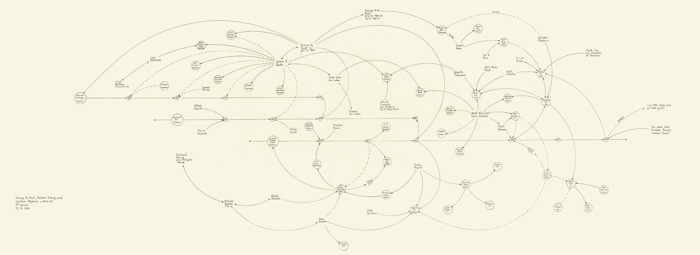
Mark Lombardi, George W.Bush, Harken Energy and Jackson Stephens, c.1979 – 91, 4th version, 1998
George W. Bush, Harken Energy, and Jackson Stephens, c. 1979-91 attempts to lay out the financial transactions and political collusions that connect the U.S. presidents Bush Junior and Senior, Osama Bin Laden’s family business, global banks and magnates. Through complex graphic systems that investigate, cross-reference and reconstruct historical facts (in particular financial frauds and political scandals), Lombardi operates what has been called “a post-Conceptual reinvention of history painting”.
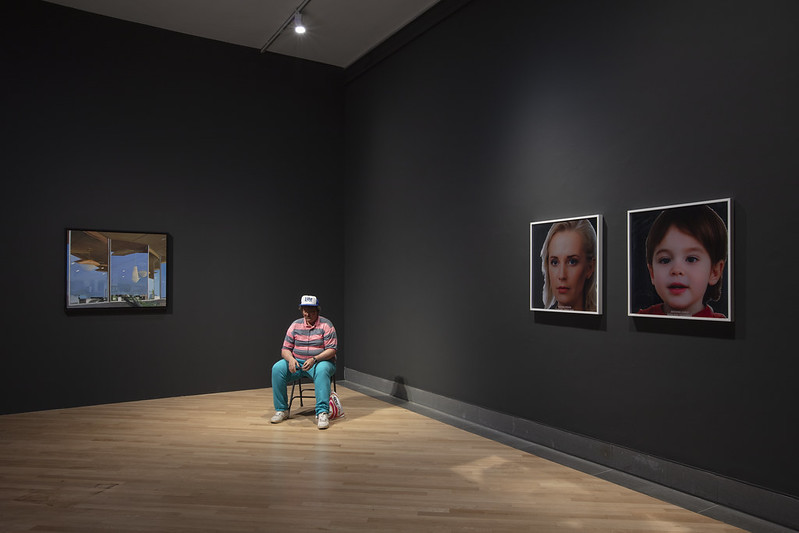
A Leap into the Void. Art beyond Matter/Salto nel vuoto at GAMeC. Photo: A. Maniscalco
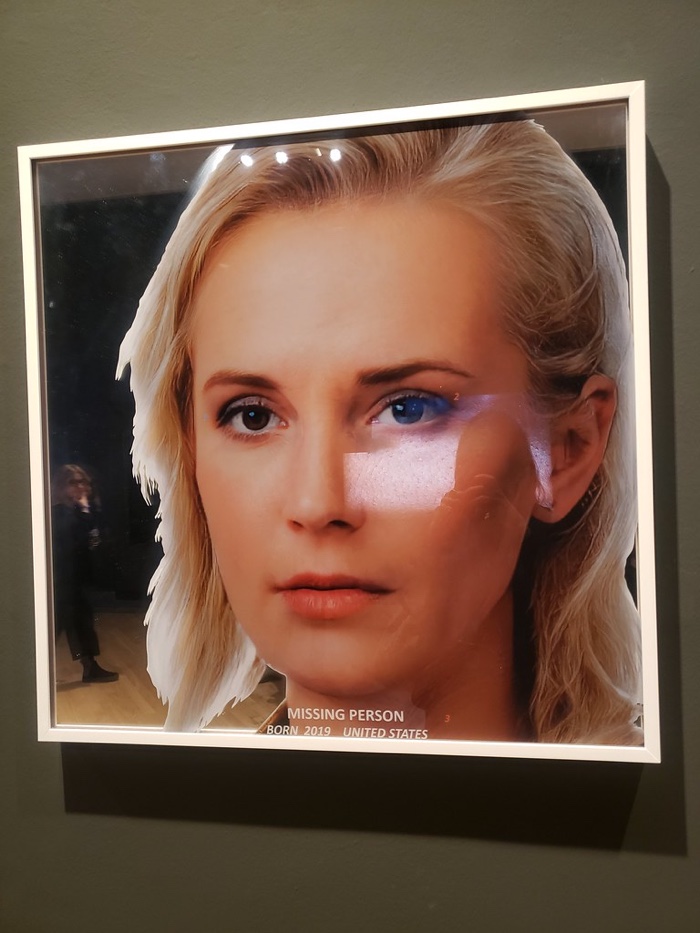
Lynn Hershman Leeson, Evidence of a Missing Person, Born 2019, 2021
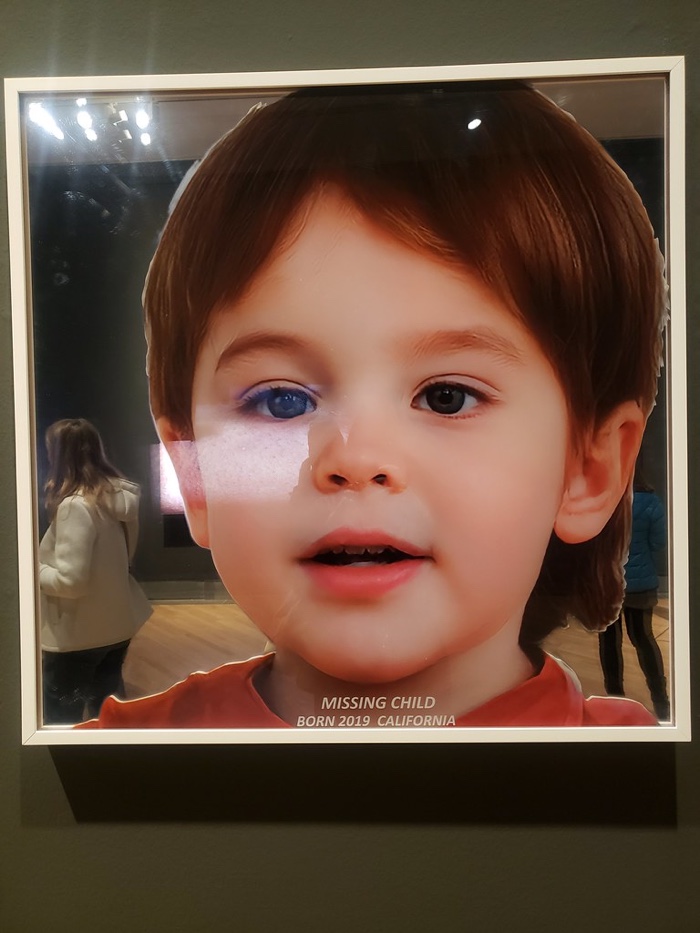
Lynn Hershman Leeson, Evidence of a Missing Child, Born 2019, 2021
Hershman Leeson’s mirror-printed Missing Person series is made in the style of the ones US consumers could find on milk cartons in the 1980s and 90s. They show the portrait of the missing person along with their year of birth: 2019. These people do not exist. 2019 is the date in which their image was created using a software that combines multiple faces captured in public contexts and using methods we know very little about. These portraits are mostly used in commercial contexts but it is easy to imagine that there are other, more pernicious, uses for these applications.
More works and images from the exhibition:
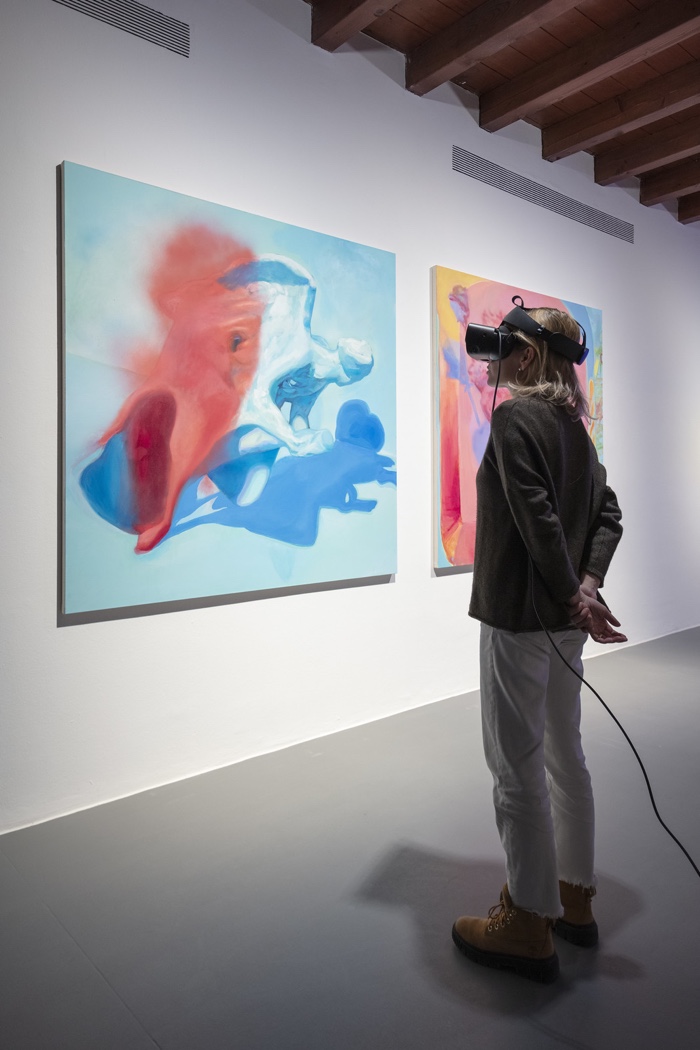
A Leap into the Void. Art beyond Matter/Salto nel vuoto at GAMeC. Photo: A. Maniscalco
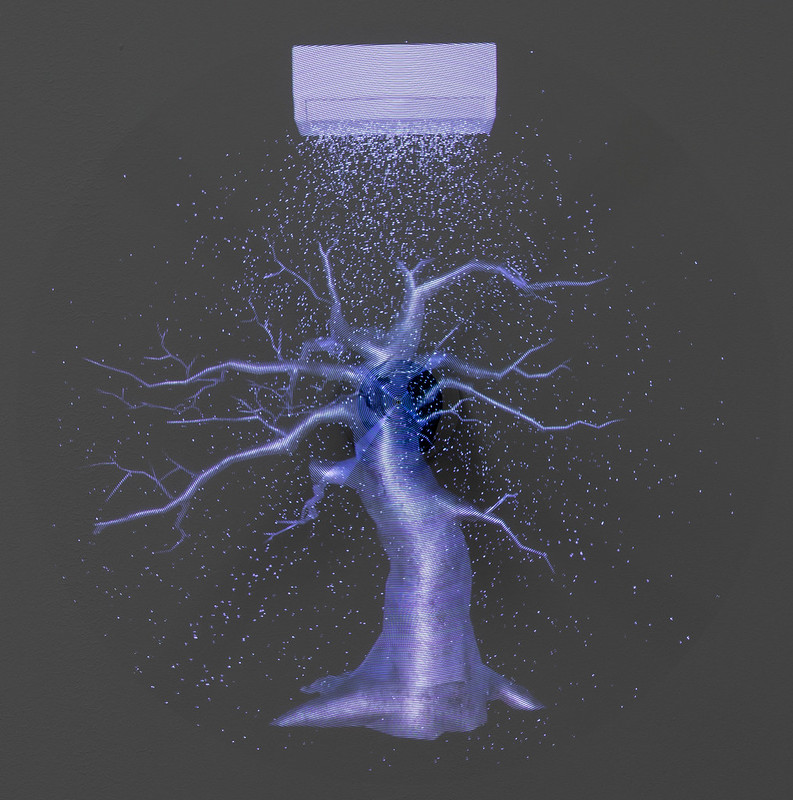
Agnieszka Kurant, Errorism, 2021. Photo: Anna Zagrodzka
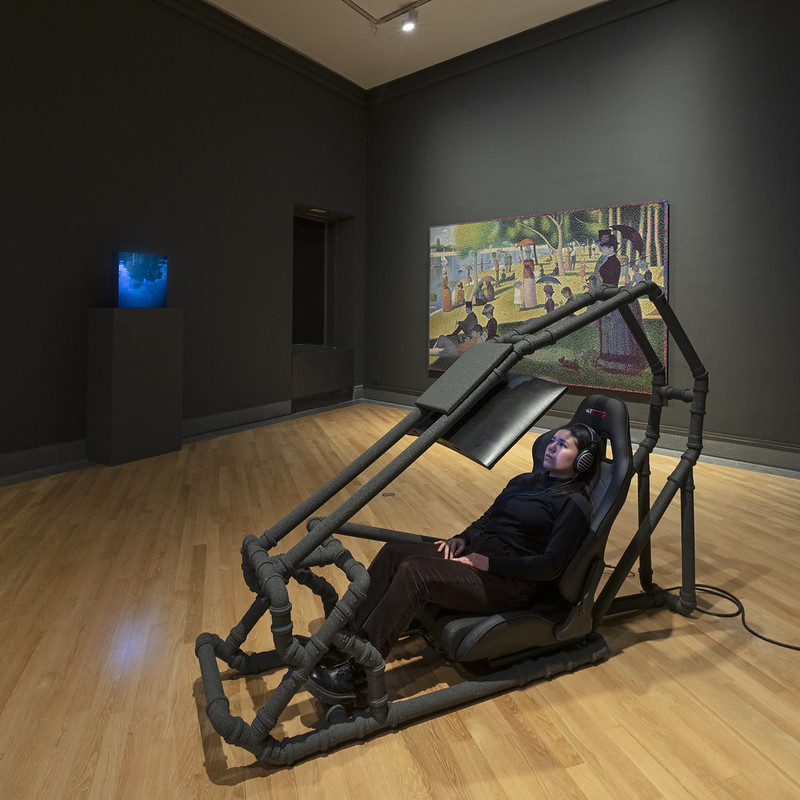
jon
A Leap into the Void. Art beyond Matter/Salto nel vuoto at GAMeC. Photo: A. Maniscalco
A Leap into the Void. Art beyond Matter was curated by Lorenzo Giusti and Domenico Quaranta. The show remains open at GAMEC in Bergamo until 28 May 23
Previously at GAMEC: Nothing is Lost: Art and Matter in Transformation.
Related stories: Training Humans. How machines see and judge us, UNINVITED. A “horror experience by and for machines”, etc.

